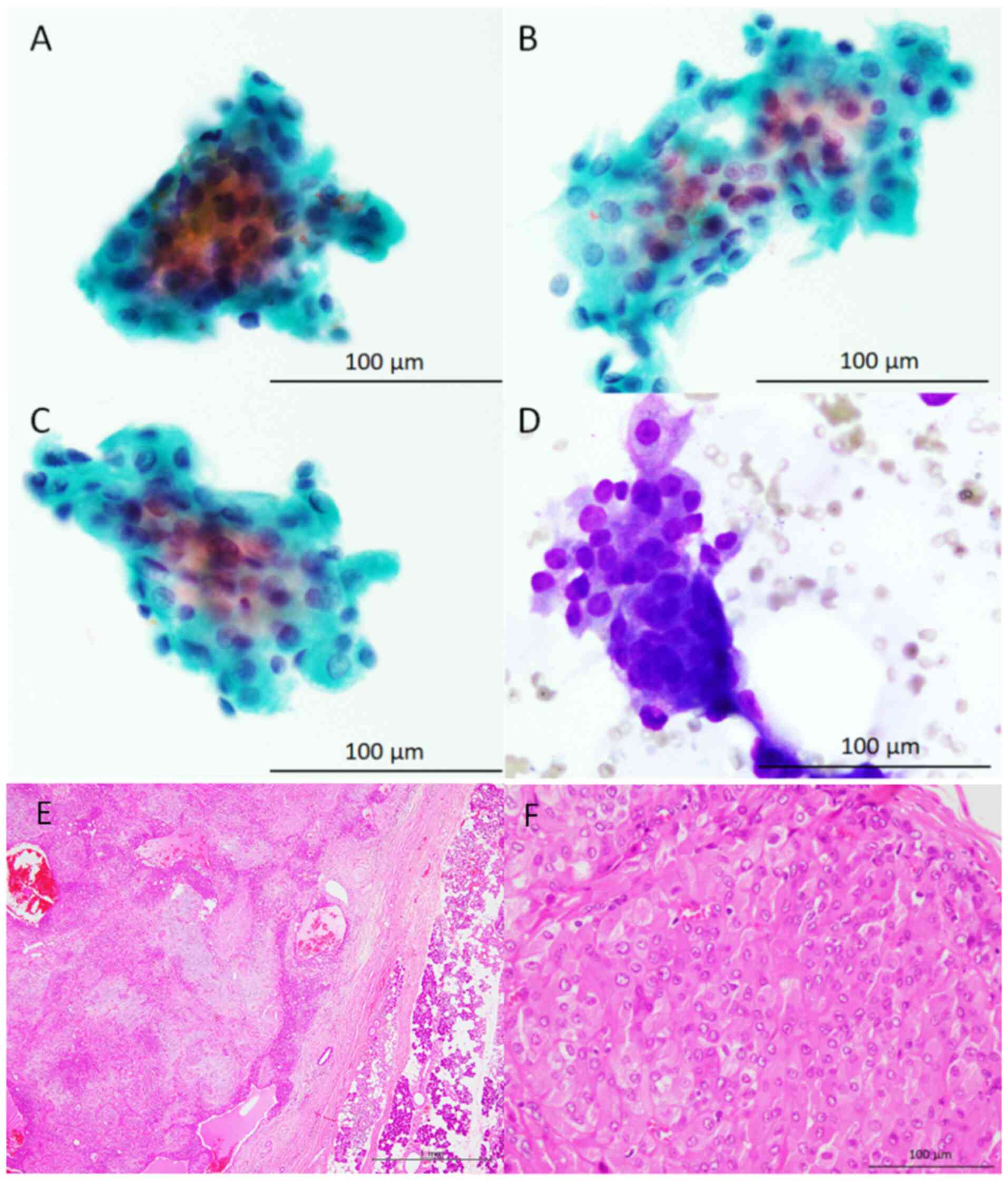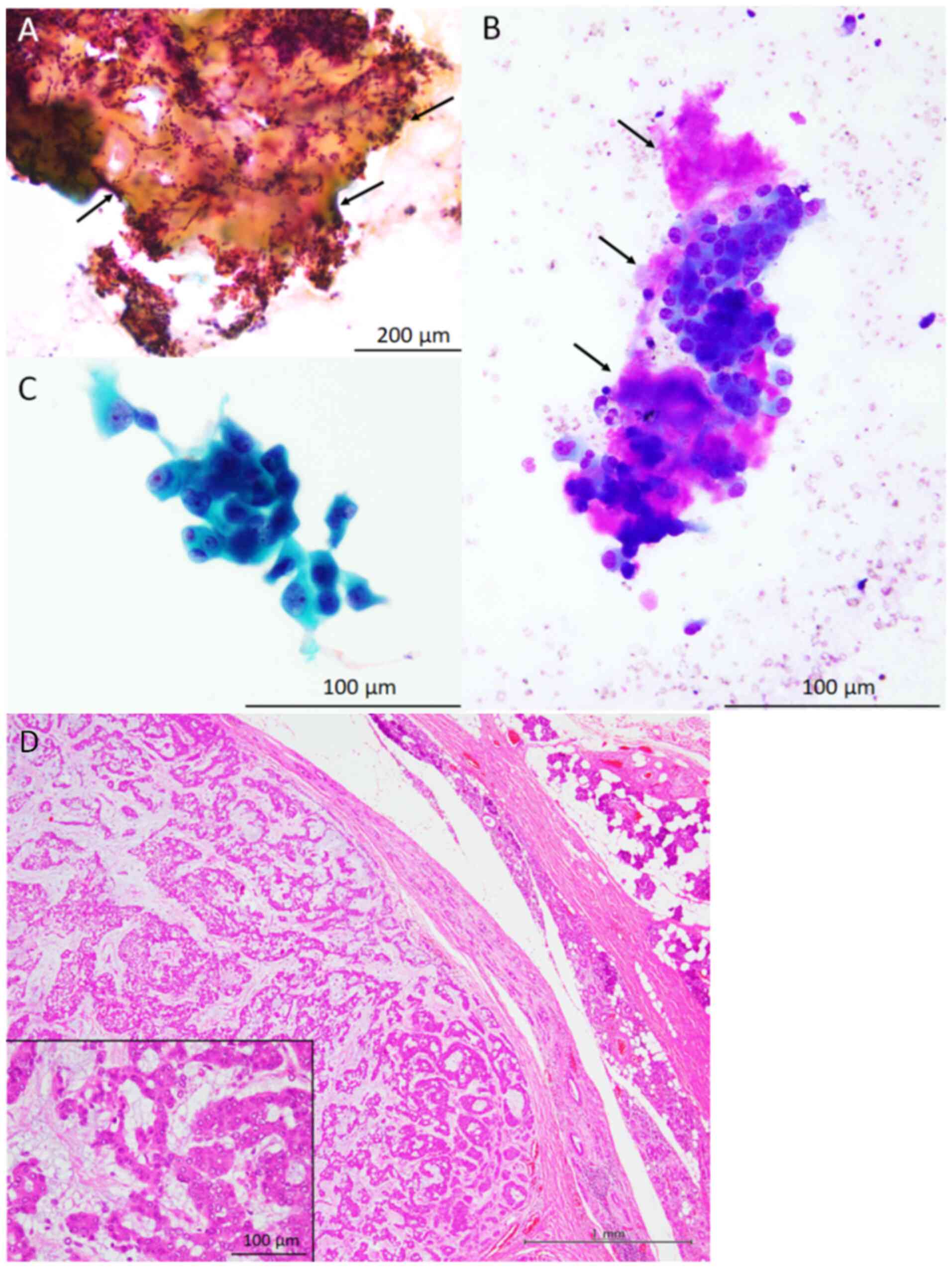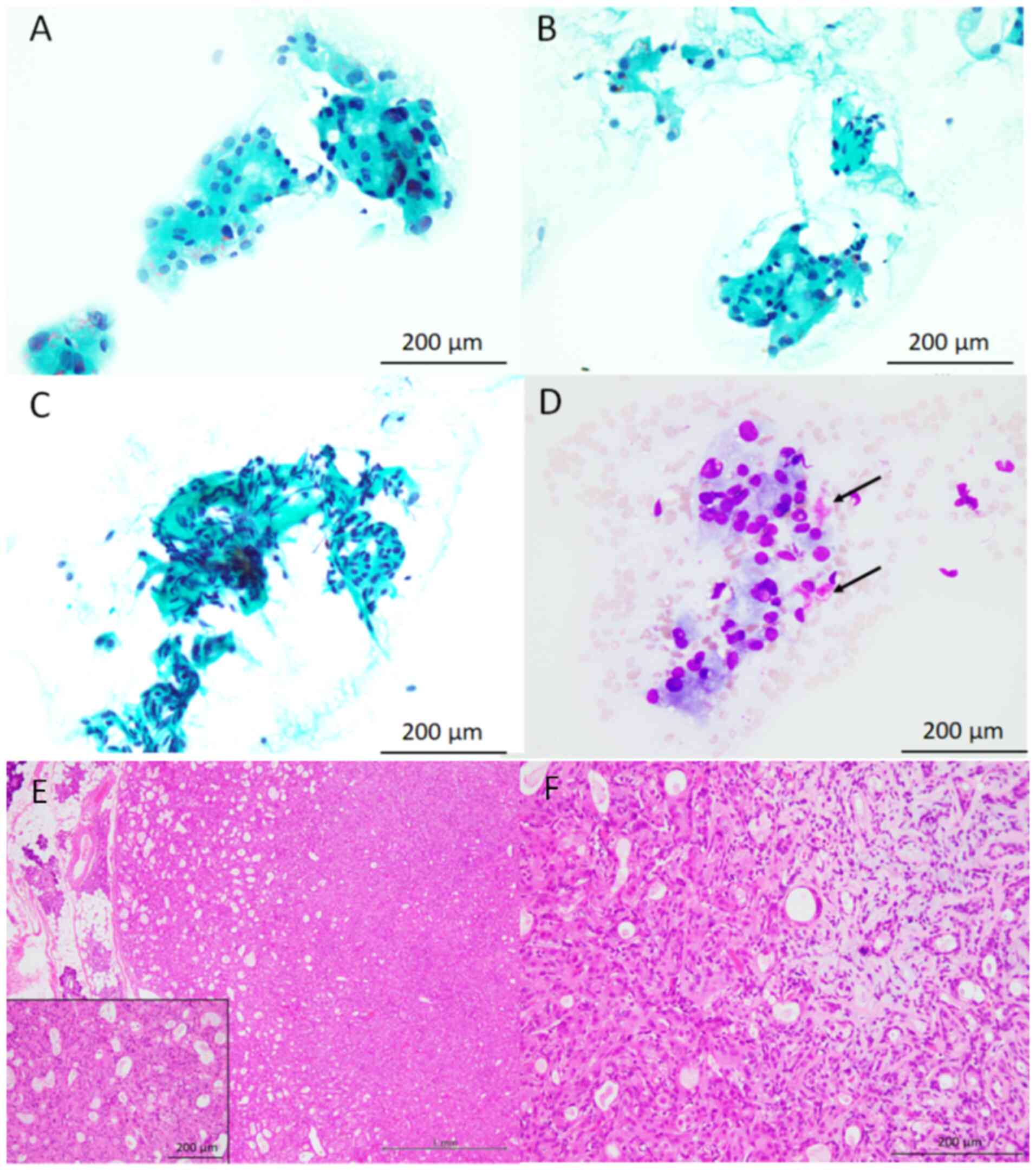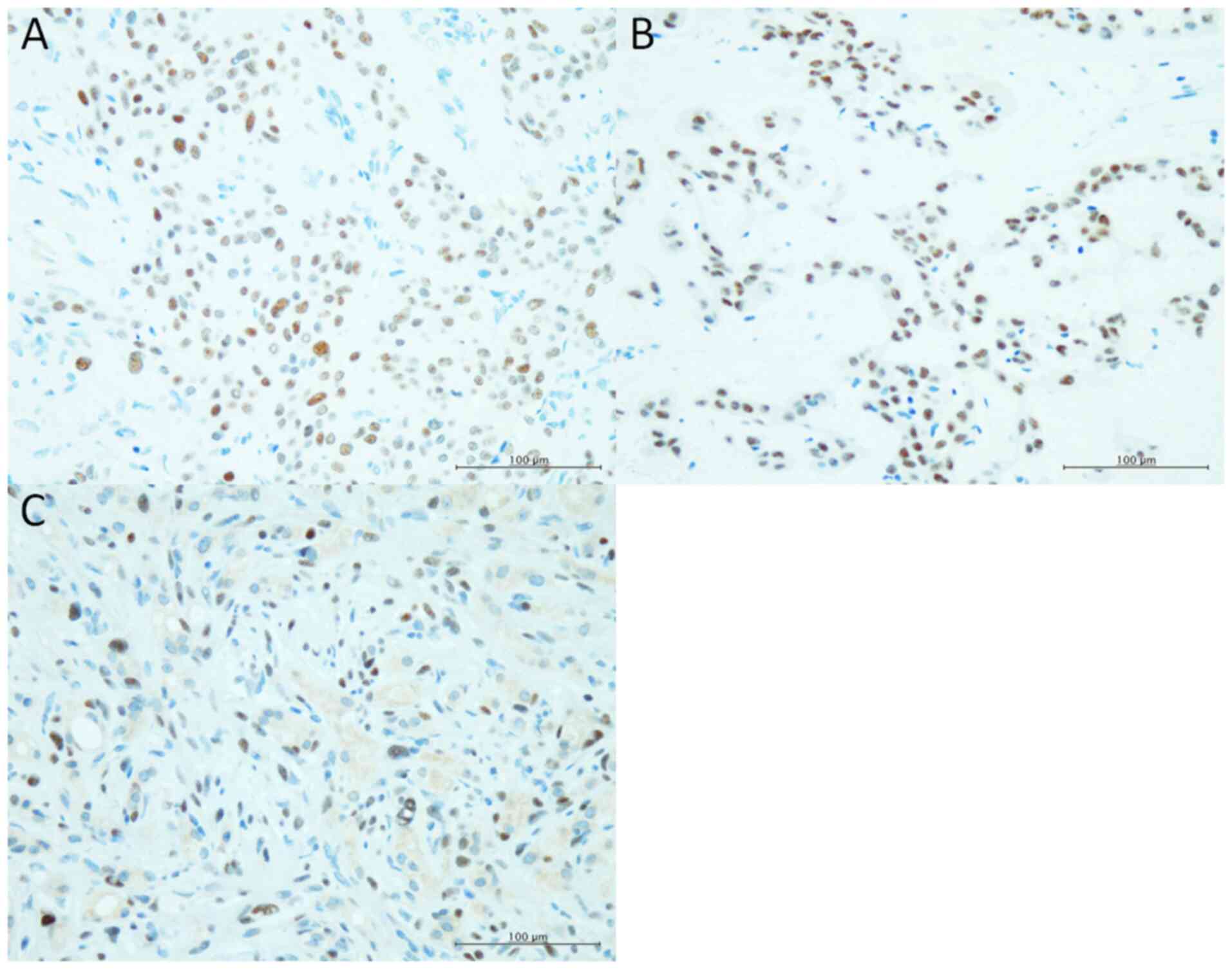Cytological features of oncocytic pleomorphic adenoma of the salivary gland: Using the Milan classification system to report 3 patients
- Authors:
- Published online on: January 15, 2025 https://doi.org/10.3892/mco.2025.2821
- Article Number: 26
-
Copyright: © Kohno et al. This is an open access article distributed under the terms of Creative Commons Attribution License.
Abstract
Introduction
Pleomorphic adenoma (PA) is the most common salivary gland neoplasm (1). Fine-needle aspiration (FNA) cytology is a well-established pre-operative approach for salivary gland tumour evaluation (2-4). The characteristic cytological features of PA, such as the presence of a biphasic cell population composed of myoepithelial and ductal cells and chondromyxoid material, are well recognised (5). Therefore, the cytological diagnosis of PA is not difficult in most cases. However, the cytological and histological features overlap with those of malignant neoplasms (including predominant cellular components without the characteristic chondromyxoid stroma and the presence of nuclear atypia); thus, diagnosis is challenging in some cases (5,6).
Oncocytes are histopathologically characterised by the presence of a rich eosinophilic granular cytoplasm owing to the abundance of mitochondria, well-defined cell boundaries, and hyperchromatic nuclei that accompany the nucleoli (7,8). In individuals aged >50 years, oncocytic metaplasia is a common finding in non-neoplastic ductal and acinar epithelial cells of the salivary gland (7,8). Moreover, Warthin's tumour, the second most common salivary gland tumour, as well as oncocytoma and oncocytic carcinomas of the salivary gland, display characteristic oncocytic morphology (9). PA occasionally presents with various types of metaplastic changes, including squamous metaplasia (5). Oncocytic metaplasia is rare in PA but can pose diagnostic challenges (7,10-14). Moreover, only two cytological reports on oncocytic PA have been published in the English literature (15,16), and oncocytic neoplastic cells contain enlarged nuclei, leading to overdiagnosis (16).
In 2018, the Milan System for Reporting Salivary Gland Cytopathology (MSRSGC) was created as a standardised and reproducible reporting system for salivary FNA cytology specimen classification (17), with the second edition published in 2023(18). MSRSGC risk stratification is based on the assumed risk of malignancy (ROM) and recommendations of therapeutic management for each tumour category (18). MSRSGC classifies tumours into seven diagnostic cytomorphological-specific categories: I, non-diagnostic; II, non-neoplastic; III, atypia of undetermined significance (AUS); IVA, benign neoplasm; IVB, salivary gland neoplasm of uncertain malignant potential (SUMP); V, suspicious for malignancy; and VI, malignant (18). The MSRSGC system is useful for the cytological diagnosis of salivary gland neoplasms (19-22). Oncocytic neoplastic lesions with non-specific atypical cytomorphological features are classified as SUMP (IVB) (18).
In this study, we have retrospectively analysed patients with oncocytic PA of the salivary gland that underwent preoperative FNA to describe the clinicopathological features of salivary gland oncocytic PA.
Materials and methods
Patient selection
Patients diagnosed with oncocytic PA of the salivary gland by postoperative pathological examination at Osaka Medical and Pharmaceutical University Hospital (Osaka, Japan), who underwent preoperative FNA from December 2020 to June 2023 were included in the study.
This retrospective, single-institution study was conducted in accordance with the tenets of the Declaration of Helsinki. The study protocol was approved by the Institutional Review Board of Osaka Medical and Pharmaceutical University Hospital (approval #2023-073). All data were anonymised. Owing to the retrospective study design, the Institutional Review Board waived the requirement for informed consent, as medical records and archived samples were used with no risk to the participants. Moreover, the present study did not include children. Information regarding this study, such as the inclusion criteria and opportunity to opt-out, was provided using the institutional website (https://www.ompu.ac.jp/u-deps/path/img/file19.pdf).
No statistical analysis was performed in this article.
Cytological analysis
The FNA specimens were stained with Papanicolaou and Giemsa stains. The cytological characteristics of the salivary gland FNA specimens, such as background features (presence of chondromyxoid material) and types of epithelial cells, were evaluated.
MSRSGC (second edition) was used to classify FNA specimens into the following seven categories: I, non-diagnostic; II, non-neoplastic; III, AUS; IVA, benign neoplasm; IVB, SUMP; V, suspicious for malignancy; and VI, malignant (18). At least two researchers independently evaluated the cytological features of all specimens.
Histopathological analysis
Surgically resected salivary gland specimens were fixed in 10% buffered formalin, dehydrated, embedded in paraffin, sectioned, and stained with haematoxylin and eosin. At least two researchers independently evaluated the histopathological features of all specimens. Histopathological features, such as the type of epithelium and the presence of chondromyxoid material, were evaluated and compared with the cytological features of the FNA specimens. Oncocytic metaplasia was defined as the presence of neoplastic cells containing rich eosinophilic granular cytoplasm, well-defined cell boundaries, and hyperchromatic nuclei, with or without nucleoli (7,8).
Immunohistochemical analysis
Immunohistochemical analysis was performed using an autostainer (Discovery Ultra System; Roche Diagnostics) according to the manufacture's instructions. 4-micrometer sections were incubated with mouse monoclonal antibody against pleomorphic adenoma gene 1 (PLAG1) (cat. no. 3B7; Abnova, dilution; 1:50) for 20 min at room temperature. Secondary antibodies were pre-diluted and were used to incubate the sections for 8minutes at room temperature [Optivew DAB Universal Kit (cat. no. 518-11427; Roche Diagnostics)].
Results
Patient characteristics
Of the patients with PA of the salivary gland who underwent pre-operative cytological and postoperative pathological examinations at Osaka Medical and Pharmaceutical University Hospital (n=142) between December 2020 and June 2023, only 2.1% (n=3) of all patients had oncocytic PA. The clinicopathological features of the study cohort are summarised in Table I. Ultimately, the study cohort included three patients with oncocytic PA of the salivary gland (Patients 1-3). This cohort included two males and one female. The median age of the patients was 34 years (range: 22-51 years). The study population comprised two males and one female. Patients 1-3 each had a lesion in the parotid gland (one and two patients on the right and left sides, respectively). No molecular tests examining PLAG1 fusions were performed in all three tumours.
Table IClinicocytological and pathological features of oncocytic pleomorphic adenoma of the salivary gland in the present series and previously reported patients. |
Cytological features
The cytological features of the study samples are presented in Fig. 1, Fig. 2 and Fig. 3 (Table I). Giemsa staining revealed myxoid material in two of the three patient samples. In the remaining patient, a clear background without myxoid material was observed. Necrotic material was not observed in any of the specimens. Small and/or large clusters of oncocytic cells, cytologically characterised by the presence of rich granular cytoplasm and relatively large round nuclei accompanying nucleoli, with a low nuclear/cytoplasmic ratio, were observed in all three patients (95-100% of the epithelial cells present in the cytological specimens were oncocytic cells). Metachromatic material, revealed by Giemsa staining, was also present around these oncocytic cells. A small number of conventional bland myoepithelial and ductal cells were observed in two of the three patient samples. No mitotic figures were observed in any specimen.
The initial cytological diagnosis according to MSRSGC (18) was SUMP (category IVB) in patient 1 and suspicious for malignancy (category V) (especially carcinoma ex pleomorphic adenoma (CXPA)) in patients 2 and 3.
Histopathological features
The histopathological features of the resected parotid gland tumours are presented in Fig. 1, Fig. 2 and Fig. 3 (Table I). The resected specimens demonstrated a relatively well-circumscribed tumour, and invasive neoplastic growth into the surrounding salivary gland tissue was not observed in any of the three tumour samples. The tumours were primarily composed of neoplastic myoepithelial cells containing small round-to-oval nuclei without rich eosinophilic granular cytoplasm or occasional ductal formations. Although cellular components without myxoid material were predominant in all tumours, these neoplastic myoepithelial cells blurred into myxoid or chondromyxoid material in at least some parts of the tumours. Oncocytic cells containing rich granular eosinophilic cytoplasm and relatively large round-to-oval nuclei with nucleoli were observed in 30-60% of the tumours. Neither necrosis nor mitotic figures were observed in the oncocytic cells of any of the tumours. Based on these features, all patients were diagnosed with oncocytic PA.
Immunohistochemical results
PLAG1 expression was noted in oncocytic cells of all three tumours (Fig. 4).
Discussion
In this study, we describe the cytological features of oncocytic PA. To the best of our knowledge, this is the first cytological case series of this rare PA variant. Various types of benign and malignant salivary gland tumours are known to have oncocytic cells (9,23). Therefore, the presence of oncocytic cells in cytological specimens from salivary gland FNA is a well-known phenomenon, and oncocytic lesions represent a subset of salivary gland tumours (18,23). Oncocytic cells are observed in Warthin's tumours, acinic cell carcinomas, mucoepidermoid carcinomas, secretory carcinomas, and salivary duct carcinoma (SDC) (18,23). Although rare, oncocytic cells have been observed in PA (7-14). Skálová et al (7) reported nine cases of oncocytic PA and 11 cases of oncocytic myoepithelioma. The researchers described the histopathological features of oncocytic PA and highlighted the oncocytic changes in PA that could create challenges in the differential diagnosis of salivary gland tumours. In particular, oncocytic cells in PA are characterised by nuclear enlargement, hyperchromasia, and pleomorphism, leading to confusion about the malignant nature of the tumour (7). Although the incidence of oncocytic PA in the major salivary glands remains unknown (that of this cohort was 2.1%), a high frequency of oncocytic metaplasia (47.6% 10 of 21 patients) in intraoral PA has been reported (14). Di Palma et al (11) reported a case of oncocytic PA in which both conventional and oncocytic components showed the same genetic amplification, indicating the same clonal origin and subsequent acquisition of an oncocytic phenotype. Advances in molecular genetics have meant that most PA cases are now characterised by gene rearrangements resulting from gene fusions containing PLAG1 or high mobility group 2 (24). Some oncocytic PA harbour PLAG1 fusion, and in some cases, initially diagnosed oncocytoma harbours PLAG1 gene rearrangements, indicating that these tumours should be reclassified as pure-type oncocytic PA (25). In addition, a recent study demonstrated that pure oncocytic PA possesses a novel PLAG1 fusion, such as ZBTB47-AS1::PLAG1 (26). Accordingly, compared to conventional PA, oncocytic PA may have distinct molecular characteristics (25,26), and the molecular differences might be present between pure type oncocytic PA and PA with focal oncocytic cells (25,26). Disease concept and classification between PA and oncocytoma may be changing. In addition, the lack of the molecular tests examining PLAG1 fusions was a limitation of the present report, although all of three oncocytic PA showed positive immunoreactivity for PLAG1. Molecular tests may be useful for diagnosis of salivary gland tumours showing oncocytic feature.
Only two cytological reports exist on oncocytic PA (15,16). The clinicopathological features of the previously reported oncocytic PA cases, as well as those of the present three patients, are summarised in Table I (15,16). In this study, all the tumours were located in the parotid glands. The median age of the patients was 51 years (range: 22-62 years). Four of the five cytological specimens contained myxoid material showing metachromasy with Giemsa staining in the background. Although the proportion of oncocytic cells in the cytological specimens was not available for one previously reported patient (16), most of the neoplastic cells present in the cytological specimens showed oncocytic morphology (n=4) and conventional PA neoplastic cells were absent in two of the patients. The histopathological features of the resected tumour showed that oncocytic cells were predominant (ranging from 30 to >85%), and cytological FNA specimens were obtained from these regions. Avoiding malignant tumour overdiagnosis remains crucial during oncocytic PA cytodiagnosis. As described above, oncocytic cells have relatively large nuclei with nucleoli; thus, malignancy is commonly overdiagnosed. The initial cytological diagnoses for the present and previously reported oncocytic PA cases were malignant (CXPA) (patient 5), suspicious for malignancy (patients 2 and 3), undetermined (patient 1), and oncocytoma (patient 4) (15,16). Therefore, three of the five patients were suspected to have malignancies. To avoid overdiagnosis, the presence of oncocytic cells in PA specimens must be considered, and oncocytic PA must be included in the differential diagnosis of oncocytic lesions of the salivary gland (16,23).
MSRSGC has been widely used for the cytological diagnosis of salivary gland tumours (19-22). This system provides ROM and recommendations for therapeutic management for each tumour category (18). In four patients with oncocytic PA for whom information on MSRSGC was available, one, two, and one patient were classified as SUMP (IVB), suspicious for malignancy (V), and malignant (VI), respectively. This lesion should be categorised as SUMP (oncocytic/oncocytoid neoplasm) (16).
Cytological differential diagnostic considerations for oncocytic PA include various types of benign and malignant salivary gland tumours with oncocytic features (23). The most important cytological differential diagnosis is CXPA because myxoid material showing metachromasy in the background suggests the presence of PA and the presence of oncocytic neoplastic cells with large nuclei and occasional nucleoli, which lead to the suspicion of carcinoma cells. CXPA is defined as a carcinoma that develops from primary or recurrent PA and accounts for 12% of all salivary gland malignancies (27). Although various histological subtypes of carcinoma occur as components in CXPA, SDC, a common high-grade carcinoma of the salivary gland, is the most frequent (27). The characteristic cytological features of SDC are the presence of small and large epithelial cell clusters in a necrotic background. These neoplastic cells have large round to oval nuclei with conspicuous nucleoli and a relatively rich eosinophilic cytoplasm (28,29). In a review of the cytological features of CXPA, both carcinoma and PA components were noted in eight out of ten cytological specimens that can be cytodiagnosed as CXPA (28). Thus, careful observation enables the detection of carcinoma components, even in specimens with small amounts of carcinoma components or when carcinoma cells are intermingled within the PA component (28). These cytological features partially resemble those of oncocytic PA in the present series. Two of three tumours of the present series were cytodiagnosed as suspected for malignancy (especially CXPA), because the most common lesion containing rich eosinophilic cytoplasm and large nuclei in the salivary gland tumour is SDC. The most important differential diagnostic feature is the presence of necrotic material in CXPA and the absence of necrosis in oncocytic PA (15,16,28). Although oncocytic cells in PA have relatively large nuclei with occasional nucleoli, typical SDC shows high-grade nuclear atypia (28,29). Thus, the degree of nuclear atypia and the necrosis status allows for differential diagnosis.
Immunohistochemical staining for PLAG1 may be useful for diagnosing oncocytic PA (both pure oncocytic PA and PA with focal oncocytic metaplasia) (25). In the present series, all of three oncocytic PA showed positive immunoreactivity for PLAG1. Moreover, the usefulness of immunocytochemical staining for PLAG1 has been reported in cytological specimens categorised as SUMP (30). Although SDC, a carcinoma component of CXPA, also exhibits PLAG1 expression, other neoplastic lesions showing oncocytic features, such as Warthin's tumour, mucoepidermoid carcinoma, acinic cell carcinoma, and secretory carcinoma, do not present with PLAG1 positivity (24). Thus, immunocytochemical analysis of PLAG1 in oncocytic cells may be useful for detecting the origin of PA.
In conclusion, we described the cytological features of a series of cases of oncocytic PA in the salivary gland. Although rare, oncocytic cells may be present in cytological specimens of PA. These oncocytic cells have relatively large nuclei with occasional nucleoli; thus, a carcinoma overdiagnosis, particularly CXPA, is common. The absence of high-grade nuclear atypia and necrotic material is an important diagnostic criterion for the differential oncocytic PA diagnosis, and cytological specimens with atypical oncocytic cells in PA should be categorised as SUMP.
Acknowledgements
Not applicable.
Funding
Funding: No funding was received.
Availability of data and materials
The data generated in the present study may be requested from the corresponding author.
Authors' contributions
NK and MI conceived the study. NK, MI, MO, HO, MT, KA, IK, YN, MU, CD, SO, RT, TT, SIH and YH analysed the cytological and/or clinicopathological data. NK and MI prepared the figures. NK and MI wrote the original draft and edited the draft. NK and MI confirm the authenticity of all the raw data. All authors have read and approved the final version of the manuscript.
Ethics approval and consent to participate
This study was conducted in accordance with the tenets of the Declaration of Helsinki, and the study protocol was approved by the Institutional Review Board of Osaka Medical and Pharmaceutical University (protocol no. 2023-073; Takatsuki, Japan). All data were anonymised. The Institutional Review Board waived the requirement for informed consent due to the retrospective study design with no risk of patient identity exposure. In addition, the present study did not include children.
Patient consent for publication
Not applicable.
Competing interests
The authors declare that they have no competing interests.
References
|
Hernandez-Prera JC, Altemani AM, de Sousa SOM, Faquin WC, Ihrler S, Katabi N, Wasserman JK and Weinreb I: Pleomorphic adenoma. In: WHO Classification of Tumours. 5th edition. IARC, Lyon, pp167-170, 2024. | |
|
Schmidt RL, Hall BJ, Wilson AR and Layfield LJ: A systematic review and meta-analysis of the diagnostic accuracy of fine-needle aspiration cytology for parotid gland lesions. Am J Clin Pathol. 136:45–59. 2011.PubMed/NCBI View Article : Google Scholar | |
|
Eytan DF, Yin LX, Maleki Z, Koch WM, Tufano RP, Eisele DW, Boahene KDO, Fakhry C, Bishop JA, Westra WH and Gourin CG: Utility of preoperative fine needle aspiration in parotid lesions. Laryngoscope. 128:398–402. 2018.PubMed/NCBI View Article : Google Scholar | |
|
Taniuchi M, Terada T and Kawata R: Fine-needle aspiration cytology for parotid tumors. Life (Basel). 12(1897)2022.PubMed/NCBI View Article : Google Scholar | |
|
Klijanienko J and Vielh P: Fine-needle sampling of salivary gland lesions I. Cytology and histology correlation of 412 cases of pleomorphic adenoma. Diagn Cytopathol. 14:195–200. 1996.PubMed/NCBI View Article : Google Scholar | |
|
Hernandez-Prera JC, Skálová A, Franchi A, Rinaldo A, Poorten VV, Zbären P, Ferlito A and Wenig BM: Pleomorphic adenoma: The great mimicker of malignancy. Histopathology. 79:279–290. 2021.PubMed/NCBI View Article : Google Scholar | |
|
Skálová A, Michal M, Ryska A, Simpson RH, Kinkor Z, Walter J and Leivo I: Oncocytic myoepithelioma and pleomorphic adenoma of the salivary glands. Virchows Arch. 434:537–546. 1999.PubMed/NCBI View Article : Google Scholar | |
|
Dardick I, Birek C, Lingen MW and Rowe PE: Differentiation and the cytomorphology of salivary gland tumors with specific reference to oncocytic metaplasia. Oral Surg Oral Med Oral Pathol Oral Radiol Endod. 88:691–701. 1999.PubMed/NCBI View Article : Google Scholar | |
|
Brandwein MS and Huvos AG: Oncocytic tumors of major salivary glands. A study of 68 cases with follow-up of 44 patients. Am J Surg Pathol. 15:514–528. 1991.PubMed/NCBI View Article : Google Scholar | |
|
Pulitzer DR and Reitmeyer WJ: Oncocytic pleomorphic adenoma of the parotid gland. J Surg Oncol. 34:198–201. 1987.PubMed/NCBI View Article : Google Scholar | |
|
Di Palma S, Lambros MBK, Savage K, Jones C, Mackay A, Dexter T, Iravani M, Fenwick K, Ashworth A and Reis-Filho JS: Oncocytic change in pleomorphic adenoma: Molecular evidence in support of an origin in neoplastic cells. J Clin Pathol. 60:492–499. 2007.PubMed/NCBI View Article : Google Scholar | |
|
Mariano FV, Vidaurre EC, Bologna-Molina RE, Carlos-Bregni R and de Almeida OP: Histopathological and immunohistochemical analysis of oncocytic pleomorphic adenoma. Indian J Pathol Microbiol. 54:193–195. 2011.PubMed/NCBI View Article : Google Scholar | |
|
Sarode GS, Sarode SC, Patil S and Anil S: Oncocytic pleomorphic adenoma of palatal salivary gland with macrophages and giant cells associated with cholesterol crystals. Clin Pract. 6(884)2016.PubMed/NCBI View Article : Google Scholar | |
|
Pérez-de-Oliveira ME, da Silva Leonel ACL, de Castro JFL, Carvalho EJA, Vargas PA and da Cruz Perez DE: Histopathological findings of intraoral pleomorphic adenomas: A retrospective study of a case series. Int J Surg Pathol. 27:729–735. 2019.PubMed/NCBI View Article : Google Scholar | |
|
Jiménez-Heffernan JA, Ortega L and Viguer JM: Cytologic features of oncocytic pleomorphic adenoma. Diagn Cytopathol. 24:147–148. 2001.PubMed/NCBI View Article : Google Scholar | |
|
Ito H, Ishida M, Miyasaka C, Okano K, Sandoh K, Fujisawa T, Iwai H and Tsuta K: Prominent oncocytic metaplasia in pleomorphic adenoma: A potential diagnostic pitfall. Diagn Cytopathol. 48:765–768. 2020.PubMed/NCBI View Article : Google Scholar | |
|
Faquin WC, Rossi ES, Baloch Z, Barkan GA, Foschini MP, Kurtycz DF, Pusztaszeri M and Vielh P: The Milan system for reporting salivary gland cytopathology. Springer International Publishing, AG Switzerland, 2018. | |
|
Faquin WC and Rossi ES: The Milan system for reporting salivary gland cytopathology. Springer International Publishing, AG. 2nd edition Switzerland, 2023. | |
|
Jalaly JB, Farahani SJ and Baloch ZW: The Milan system for reporting salivary gland cytopathology: A comprehensive review of the literature. Diagn Cytopathol. 48:880–889. 2020.PubMed/NCBI View Article : Google Scholar | |
|
Higuchi K, Urano M, Akiba J, Nogami M, Hirata Y, Zukeran Y, Moriyoshi K, Tada Y, Fukushima M, Obayashi M, et al: A multi-institutional study of salivary gland cytopathology: Application of the Milan system for reporting salivary gland cytopathology in Japan. Cancer Cytopathol. 130:30–40. 2022.PubMed/NCBI View Article : Google Scholar | |
|
Tochtermann G, Nowack M, Hagen C, Rupp NJ, Ikenberg K, Broglie MA, Saro F, Lenggenhager D and Bode PK: The Milan system for reporting salivary gland cytopathology-A single-center study of 2156 cases. Cancer Med. 12:12198–12207. 2023.PubMed/NCBI View Article : Google Scholar | |
|
Taniuchi M, Kawata R, Omura S, Haginomori SI, Terada T, Higashino M, Kurisu Y and Hirose Y: A novel clinically oriented classification of fine-needle aspiration cytology for salivary gland tumors: A 20-year retrospective analysis of 1175 patients. Int J Clin Oncol. 26:326–334. 2021.PubMed/NCBI View Article : Google Scholar | |
|
Lubin D, Song S, Zafar HM and Baloch Z: The key radiologic and cytomorphologic features of oncocytic and oncocytoid lesions of the salivary gland. Diagn Cytopathol. 47:617–636. 2019.PubMed/NCBI View Article : Google Scholar | |
|
Stenman G, Fehr A, Skálová A, Poorten VV, Hellquist H, Mikkelsen LH, Saba NF, Guntinas-Lichius O, Chiesa-Estomba CM, Andersson MK and Ferlito A: Chromosome translocations, gene fusions, and their molecular consequences in pleomorphic salivary gland adenomas. Biomedicines. 10(1970)2022.PubMed/NCBI View Article : Google Scholar | |
|
Baněčková M, Uro-Coste E, Ptáková N, Šteiner P, Stanowska O, Benincasa G, Colella G, Vondrák J Jr, Michal M, Leivo I and Skálová A: What is hiding behind S100 protein and SOX10 positive oncocytomas? Oncocytic pleomorphic adenoma and myoepithelioma with novel gene fusions in a subset of cases. Hum Pathol. 103:52–62. 2020.PubMed/NCBI View Article : Google Scholar | |
|
Alsugair Z, Perrot J, Descotes F, Lopez J, Champagnac A, Pissaloux D, Castain C, Onea M, Céruse P, Philouze P, et al: Characterization of a molecularly distinct subset of oncocytic pleomorphic adenomas/myoepitheliomas harboring recurrent ZBTB47-AS1::PLAG1 gene fusion. Am J Surg Pathol. 48:551–561. 2024.PubMed/NCBI View Article : Google Scholar | |
|
Griffith CC, Thompson LDR, Assaad A, Purgina BM, Lai C, Bauman JE, Weinreb I, Seethala RR and Chiosea SI: Salivary duct carcinoma and the concept of early carcinoma ex pleomorphic adenoma. Histopathology. 65:854–860. 2014.PubMed/NCBI View Article : Google Scholar | |
|
Okano K, Ishida M, Sandoh K, Fujisawa T, Iwai H and Tsuta K: Cytological features of carcinoma ex pleomorphic adenoma of the salivary glands: A diagnostic challenge. Diagn Cytopathol. 48:149–153. 2020.PubMed/NCBI View Article : Google Scholar | |
|
Klijanienko J, El-Naggar AK and Vielh P: Fine-needle sampling findings in 26 carcinoma ex pleomorphic adenomas: Diagnostic pitfalls and clinical considerations. Diagn Cytopathol. 21:163–166. 1999.PubMed/NCBI View Article : Google Scholar | |
|
Sanchez-Avila M, Tjendra Y, Zuo Y, Ruiz-Cordero R, Garcia-Buitrago M, Jorda M, Gomez-Fernandez C and Velez Torres JM: Don't SUMP it! Utility of PLAG1 immunocytochemistry in basaloid SUMP subcategory. Cancer Cytopathol. 132:60–68. 2024.PubMed/NCBI View Article : Google Scholar |













